Dorothea Quarry short circular (1.37miles but lots to explore!)
If you haven’t already noticed, I LOVE exploring old, derelict buildings. It’s a hobby my husband doesn’t understand at all! It’s the feeling of history in these places that gets me… the knowledge of all the people and stories that have come before. There’s a sadness in these crumbling buildings. It’s Easter holidays currently. Anwen was at nursery and so I decided to take Megan back to Dorothea Quarry in the Nantlle Valley. Dorothea has everything- beautiful views, history in spades and so many derelict buildings even I don’t know what to do with myself! If you march round without taking the time to do some exploring, this is a very short walk- only 1.37 miles according to the OS maps app. We did 2.79 miles and spent 2 1/2 hours exploring!
Dorothea is open to the public and the paths are very clearly signed, which is needed as this is a pretty dangerous location. At the end of the day Dorothea is an abandoned quarry with all the dangers that entails. There are steep drops, derelict buildings, uneven floors, and a big risk of landslide (in fact part of the original path has been diverted due to a big landslide which was caught on video. https://www.dailypost.co.uk/news/north-wales-news/video-captures-jaw-dropping-moment-18546406) I was last here in 2020 when Anwen was tiny and in a carrier but I wouldn’t risk bringing her now she’s walking and can be a bit wild and unpredictable! Megan can be reasoned with and follows instructions even if some whinging occurs! Having said all of this - Dorothea is a magical place and well worth visiting before it is lost to time.
Distance: 1.37miles/2.20km(according to OS app - although we doubled our distance just by exploring.)
Time taken: 2hrs 30 (including a picnic)
Elevation gain: 255ft / 77.72m (OS app)
Parking: Yes. Free.
Facilities: None.
Walkers: Me (35years, fat but getting slowly fitter), Megan (6yrs, full of energy and never stops talking)
1. To park we need to head to the village of Talysarn (Tahl err sahrn) in Dyffryn Nantlle (Duff rin Naunt ller). Weird fact about Talysarn- two secret agents were found bugging a public telephone there in 1982! It was probably to do with the Meibion Glyndwr campaign where holiday homes across Cymru were burnt down in protest at the ownership of second homes by rich outsiders, making it difficult for locals to stay in their areas. Welsh singer Dafydd Iwan wrote a song about this incident called Ciosg Talysarn https://m.youtube.com/watch?v=TRLAfgOOZ5Y.
Follow the B4418 out of Penygroes and at the T junction turn left into the village and then right onto Bryncelyn Road. Follow this road until you get to a roundabout. I park on the grass at the edge of the roundabout. The dead end road that comes off the roundabout is the beginning of the road into the quarry.
The roundabout looking back at the village.
Off we go.
We set off down the dead end track. Obviously as a circular route it’s possible to go either way but we went anti-clockwise this time, turning right off the track and onto a footpath. There is a kissing gate but you can go around it!

Follow the dead end track.
Turn right off the track onto the footpath.
Once through (around) the gate we come into an open field with paths heading in different directions. We take the one which goes diagonally to our left heading around the hill and towards a fence. We come to another gate that you can just go around which brings us into the boundaries of Dorothea. There is a sign with a map of the quarry which is very helpful.
Head diagonally left.
Entering Dorothea.
Map of Dorothea.
I suppose this is a good point to stop and give some general information about Dorothea and her history.
Dorothea Quarry.
The quarry commenced working in the early 1820s, although there were a number of smaller workings on or near the site before this. About 1829 it was leased by William Turner who named the workings Cloddfa Turner. When his son took over as manager the quarry was renamed Dorothea, apparently after the wife of the landowner Richard Garnon. In 1848, the elderly William Turner, apparently unhappy at the stewardship of his business affairs at Dorothea by his son, decided to sell his lease of the quarry as a going concern. With an asking price of £3000, the sales circular described the quarry as ‘… A full operation, worked by steam and water power… provided with every requisite for the efficient working of it, in engines, pumps, weighing machines, sheds, railroads, and wagons.’
The successful purchaser had the distinction of being the most important contemporary local Welsh joint-stock company. The promoters were a group of quarrymen, leasing and working the small nearby Pwll Fanog Quarry. With their entrepreneurial zeal fighting against innate pessimism in taking on such a large concern, a campaign to recruit shareholders was mounted locally amongst their peers, including several persons who had undoubtedly amassed a nest-egg as slate carters before the opening of the Nantlle Railway in 1828.
The shares in the new Dorothea concern had a par value of £50 and were sold fully paid up so as to raise the £1500 deposit needed to secure the interest of Turner and Morgan. However, the initial rate of sale appeared insufficient to raise the deposit before the set date, probably because men who had risen from poverty to relative wealth were unwilling to risk their gains on a quarry which had been inexplicably closed by one of the most successful entrepreneurs of his day.
Fortunately, for the promoters, they were able to involve the minister of the local Calvinistic Methodist chapel, who had also been a working quarryman. The Reverend John Jones, had been enticed to Tal Y Sarn quarry in 1821, where he soon married Fanny Edwards, the daughter of one of the men who first open the Dorothea site. Not only did Jones have access to sound commercial expertise, but his charismatic preaching had created a national personal following (almost a cult in itself) and his participation in the Dorothea scheme created the confidence in the enterprise that was previously wanting.
Soon, enough shares had been sold to pay the deposit and secure the quarry, but the raising of the remaining £1500 over 18 months proved more difficult in the face of a downturn in the slate trade. Jones practically single-handedly saved the day by canvassing friends and relations, being particularly successful amongst the Methodists in Denbighshire, where he had been a farm labourer.
The first two years (1849 to 1851) of trading for the new Dorothea Slate Company were not particularly auspicious, with insufficient development capital and a lack of managerial and commercial experience in the face of a depressed market creating despondency amongst the members. With the dismissal of the founding manager and chief promoter, William Owen, in 1851, the ‘Welsh Company’ turned to John Jones as its only salvation, a thankless task which he accepted probably as the sole alternative to closing the concern and the loss of all his own and others’ savings.
The consequence was that John Jones became all things to all men and suffered accordingly. Attempting to save the Dorothea enterprise would have created sufficient problems in itself, but the additional demands of the Methodist cause, including long preaching tours on horseback throughout the Principality was a burden beyond even the capabilities of Jones. Unsurprisingly, John Jones‘s ministry suffered from the long hours spent at the quarry, and with his (probably correct) policy of cutting the quarrymen's pay and numbers to balance the books, both the local community and the religious establishment railed against him.
John Jones suffered a near-fatal accident on a new haulage incline at the quarry in 1852 or 1853, from which he was fortunate to escape with only a badly damaged foot. This saw Jones relinquishing active managership of the works to John Robyns, a senior Methodist deacon of Fron. Jones resumed his preaching for a while, but went into decline and died in 1857.
Under John Robyns, even with the increase in trade by the late 1850s, Dorothea was generating little profit and virtually no dividends, and was unsuccessfully offered for sale. Moreover, excuses did not wear in the early 1860s, when continuing disappointing results flew in the face of roaring trade and the four-year waiting list for slates. Most of the old guard, including the widowed Mrs Fanny Jones, sold out of the concern by 1864, and almost all the shares were purchased at a fourfold premium by her son-in-law, John Williams of Llangernyw. With the appointment of the outstanding J.J. Evans as manager in 1864, the tide turned, and the golden age of Dorothea began, when it became known to the quarrymen as ‘Canaan’- the land of milk and honey. John Jones was vindicated and his detractors who had sold their shares lost out of the bonanza of two decades of large dividends.
Since quarrying ended in 1970, the Dorothea quarry has flooded and become a popular site for scuba diving despite the lack of facilities and the fact that diving was officially banned. The unregulated nature and depth of the site has encouraged some divers to overestimate their capabilities and 2014 saw the death of Dorothea’s 25th diving victim. After a period of closure during 2018, an agreement was arranged that allowed diving for members of the North Wales Technical Divers Club only.
Dorothea quarry sits at the bottom of the wide Nantlle Valley and consists of six pits, the deepest dropping 106m from the surface. The slate veins here run vertically, allowing unusually deep vertical pits to be dug. Because the pits fall below the water table they needed to be constantly pumped to stay dry. Flooding was a constant problem at Dorothea and in 1884 several men were drowned when the pit was engulfed. In 1895 the Afon Llyfni which flowed through the valley was realigned and deepened to flow to the south of the workings. This cured the problems to some extent but as the workings deepened the need to continually pump out water became a constant drain on profits. A Cornish beam engine was installed in 1904 to pump the pits and replace the waterwheels; it stayed in use until 1951 when it was replaced with electric pumps. This was the last new Cornish engine to be built. It remains in situ in it’s Grade 1 listed engine house.
We follow the path downhill. On our right is one of the smaller flooded pits, South Dorothea. South Dorothea was originally called Cornwall (it is thought that the quarry was first worked by ex- copper miners from Cornwall). There are already the remains of buildings to be seen dotted around. The path joins a wider track and we turn right onto this towards the Cornish beam engine. Before that though, we step onto the open sections and have a look at the twll (hole) in front of us.
Remains.
The smaller South Dorothea on our right… still quite a drop!
More unidentifiable remains.
This girl explores and gets muddy… but she does so with style!
Take the track to the right but enjoy the view first!
The biggest pit at Dorothea.
Follow the track. We see the roof of the pumphouse in front and one of the towering ‘pyramids’.
Another peek at the smaller pit.
The clock- also the Dorothea quarries’ war memorial.
2. We soon come to the foot of the imposing Cornish beam engine. It has really deteriorated since I visited in my teens which is so sad, but it’s still an impressive sight. I don’t think pictures can really do the building justice.
Cornish beam engine.
The pumphouse was built in 1904 to house a Holman Cornish beam engine- one of the last ever built and believed to be the newest still in existence. This engine was capable of pumping 10 gallons of water per second from a depth of 500ft. It served until 1951 when it was replaced by a 60hp electric pump. The main beam (of which half can be seen outside the building) is steel casting and weighs over 23 tonnes.
The pumphouse was also the Dorothea’s war memorial. The World War I memorial stone reads (translated from Welsh) “The clock above was placed in memory of peace and of those from these quarries who lost their lives in the Great War 1914-1918”. A second stone lists the fallen of World War II - “in loving remembrance of these sons that fell in the war 1939 - 45.” The Dorothea memorial stones were moved to the churchyard of Eglwys St. Ioan, Talysarn in 1978.
Cornish beam engine pumphouse.
What remains of the pumping rod attached to the end of the beam. As the beam rotated it activated the pump.
This was taller than me!
1904 - date the building began for the pumphouse.
The clock- also the Dorothea quarries’ war memorial.
After the pumphouse we pass by the foot of one of the ‘pyramids’, the Dorothea incline, where trucks of slate and rubbish (waste slate) would have been hauled up by a cable system with a winding drum at the top. After passing this, we reach a section full of derelict buildings to explore as this would have been the main processing area. The largest building is further on, and only the gable ends remain (although one of those looks close to collapse) - this would have been the integrated mill and dressing shed. The other buildings in this area would have been offices, workshops, smithies, and stables. Dorothea had an extensive internal tramway system and evidence of this can be seen all through the area. We decided to have our picnic here, sitting on a massive piece of slate in front of the more fragile gable end of the mill.
I love finding these carved names and initials!
Offices?

Gable end of the mill.


Not slate? Unusual.
When we meet back up with the main track we’re in an open area which overlooks the big pit. There is also a steep track down to the lake which Megan decided we must go down. I had never been down to the water before so I agreed we could on the proviso she didn’t moan on the way back up!
As we say in Welsh “Wariar”.
Y Capel
View from our picnic spot.
The rubbish tramway.
Strangely wholesome graffiti.
Taken from the steps leading up to the engine house.

The further gable end.
3. We continue on following the path around the big pit and it isn’t long before we get to the diversion. The path has been well blocked off and the signs are very clear about which way we should be going. We head up to the right on probably the steepest section we encounter all afternoon. I imagine it could be slippy in wet weather but it wasn’t a problem at all for us today… though I was glad I didn’t bring Anwen!
Diversion.

Looking down at the big pit and the second ‘pyramid’.
At the top we continue to follow the path which is really obvious and drops down again until we return to the level we were at previously. The views at the top are incredible though.
Chance for a selfie. There was whinging. The sun was in her eyes!
We had to do some drawing on slate!
We keep heading left - there are other, longer routes to take if you go through the gate at the bottom but we didn’t have the time today. Eventually we get to a fork. The right takes you on the main track and the left takes you along the old tramway. That looked more exciting to Megan so we went left. Ultimately though you come out in the same place.
Right or left?
Not slate? Unusual.
Steep track down.
So peaceful.
Is it cold mum?
I’m glad we went down as it was so peaceful there. However, I couldn’t help but feel a little unnerved at the thought of how deep that water is. It’s incredible to think of what’s under there. According to North West Dive Sites “Many old huts and quarry workings remain such as cranes, cables, and tunnel sections. The car stack is a pile of cars on the west side of the quarry, which have been dumped in and fallen on top of one another. The deeper you go, the older the cars are. Not far from the car stack is a Ford Escort that seems to stick out of the quarry wall.”
In her defence, Megan kept to her word and didn’t moan once on the way back up… though I puffed and panted a bit!
Again, there’s a choice of paths from this point. The main track, or to follow the tramway again. We retrace our steps a little to where we emerged previously and choose the tramway.
Go back to the tramway.
The path.
Not long after this we start to come across the first of numerous derelict residential properties in the form of some cottages, stables, and a considerably bigger farmhouse type building. This blog https://treasuremaps.weebly.com/tracks/a-dorothea-miscellany gives some really useful information and some incredible old pictures. Apparently one of the cottages in front (with the slate divide) was once Tommy ‘Run’s’ house. Thomas Williams managed the horses used to haul the slate along the tramway. ‘Y ryn’ (the run) was the name for the journey made by the horse train.
A photo by Geoff Charles of the last two horses to haul the slate wagons. Corwen is the grey mare and her son, Prince, is in front. Tommy is probably behind Prince. They were owned by Oswald Jones.
The cottages (front) and stable (right)
Fireplace.
Pair of cottages.
I love the massive piece of slate that separates the doorways.
Stables.
Nature reclaims.
Pair of cottages.
At the back of the cottages - a constant reminder that we are in a quarry.
The farmhouse isn’t as easy to access as it’s front garden is completely overgrown. It is possible to go around the back though. According to the above blog, this house was lived in by a Mr Pritchard.
Front of the farmhouse from above.
Stairs to the first floor that go up and over a ground floor doorway.
Big inglenook.
Going around the farmhouse brings us in a loop back to the track, so we continue on. After passing the cottages again parts of the path become very muddy and boggy but there’s plenty of stones to use to keep your feet reasonably dry. After the boggy section we find a tunnel on the right with a stream running through it. Megan wants to go in, but that’s too much exploring even for me! The tunnel was for the original 1820s route of the Nantlle Railway, as the tramway was originally called.
Tunnel.
4. The path we are on now is also the tramway and passes to the back of Plas Talysarn (Talysarn Hall). John Robinson, the quarry owner at the time, diverted the railway past the back of the house. Making money was more important to him than having the noise of clattering wagons disturb the household in workday hours. He was personally superintending the works, unlike many other owners. We get the occasional glimpse of the Plas through windows in the big wall on our left but eventually there’s a gap we can get through. On our left are the remains of the Plas itself and on our right the impressive stables and kennels which were later converted into quarry washrooms. The hall itself is in very poor condition and completely fenced off. When I came for the first time in 2010 we were able to explore the inside although there wasn’t much left then.
Plas Talysarn
The archway entrance to the kennels and stables.
Plas Talysarn
Talysarn Hall was built in the 18th Century on the site of a 17th century farmhouse and was once the residence of the Robinson family who owned Tal-Y-Sarn quarry and had shares in several other workings in the area. John Robinson, unlike many other quarry owners in the area, was clearly well respected by the workers and was asked by the North Wales Quarryman’s Union to represent them in negotiations with the manager of Dinorwig when attempting to break the deadlock of the 1885 - 1886 lock-out. He was apparently a man of the people and generous to those in need.
John’s young second wife moved ‘home’ to London and his son, Tom‘s second wife seems to have left in 1910, leaving local staff to look after the house, which was used as a holiday home and also part was a flat used by a brother-in-law from Bolton who visited to oversee the running of the quarry until it succumbed in 1925. The family held onto the house (but the abandoned back wing had fallen down in the 1930s) until sold to Dorothea Company in 1942 for use as offices (when new rendering was put on, and the bay windows and glass verandah removed), but the wife of the official who should have lived upstairs refused to go there. The place was boarded up and was progressively looted of electric cable etc. in the 1950s.
After the quarry took over the hall, the stables were used as a shower block for the workers. The kennels would’ve been for hunting dogs as the family, like some other major quarry owners of the time, copied the aristocracy in country sports i.e. hunting, and shooting.
Somewhere in the now overgrown grounds (I am yet to find it) is the base of a large fountain. The fountain was installed circa 1904 as a 21st birthday present for Thomas Robinson‘s daughter, Ada -granddaughter of John Robinson. Apparently the family used the fountain as a swimming pool as it is about 18ft in diameter and would have been filled to around 3ft. From the edge of the fountain is a steep drop to Dorothea pit.
We followed the main track from the front of the hall for the rest of our walk, basically what was the driveway. Because of this, I missed one of my favourite buildings, the Chapel. We can’t have that so I’m including some pictures that I took on our last visit in 2020 (when Anwen was only a few months old and lockdown must’ve been eased for a bit- different times). It’s definitely worth looking out for although I clearly can’t actually remember where it is and I don’t know what state it’s currently in.
Chapel in 2020
Chapel in 2020
From inside the chapel in 2020.
The chapel is on the original driveway to the Plas, which was later occupied by the gardener, and last lived in the 1930s. It’s a complex range of buildings having a complex history. The portion next door (to the right) has a very old cottage as its lower inside, with a new bit built on the front and over the top (first floor). The back end of this (with a main door and porch opening onto the tramway) was the Tal Y Sarn Quarry main office. The parts that I have taken pictures of was a private church for the Plas for a while, before being converted into a back office. There was no church closer than Llanllyfni before St John’s in Talysarn, 1871, and that was paid for by John Robinson of Plas Talysarn. The east window was dedicated to his first wife, who died young in 1871. The house and office were used by Dorothea quarrymen as a mess room and stores when work started to expand Dorothea into the Plas gardens after the war, but an arsonist saw the end of the place in the early 1950s.
Anyway, we carry on down the drive, passing through what would have once been an impressive gateway I imagine.
Gateway.
Driveway.
On our right and below us we come to the final explore of the day. Glen Cottage was the gatehouse for the Plas and was connected to a series of workshops and forges called Ty’r Efail. There was also a large pump house for the Tal-Y-Sarn pit.
After this final explore we follow the driveway back to the car. Worth noting on the right though is the flooded pit of the Tal-Y-Sarn Quarry.
It was really sad to see how much everything had deteriorated since we were last here nearly 2 1/2 years ago. I can’t wait to come back again though. Dorothea never gets boring.
Sources
Book- Dyffryn Nantlle - a landscape of neglect by Alan Carr
Article A Painting of Dorothea Quarry c. 1857 by Gwynfor Pierce Jones and Peter Lord - Industrial Gwynedd Gwynedd Diwydiannol Volume 3 1998 Plateway Press


















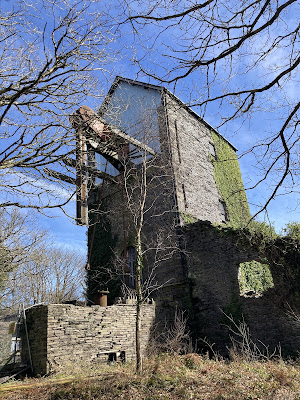















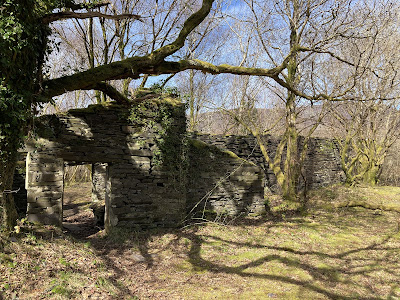













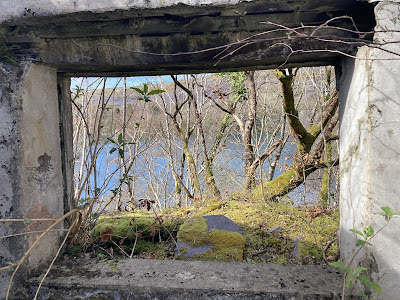










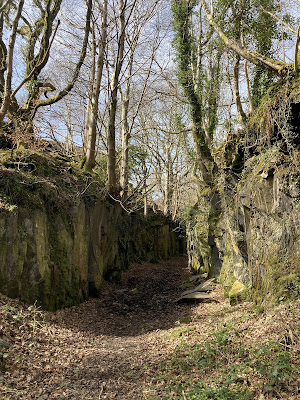






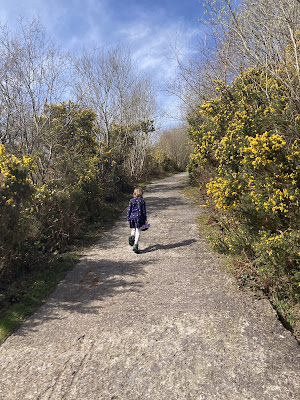








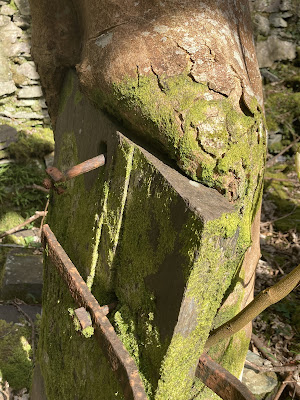






















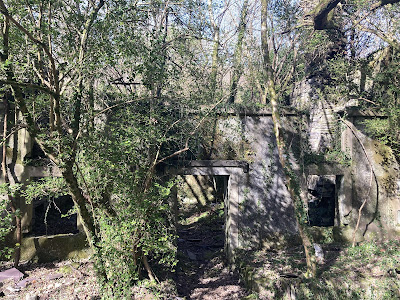







Comments
Post a Comment